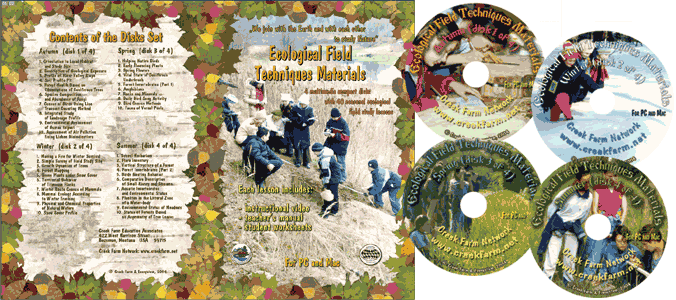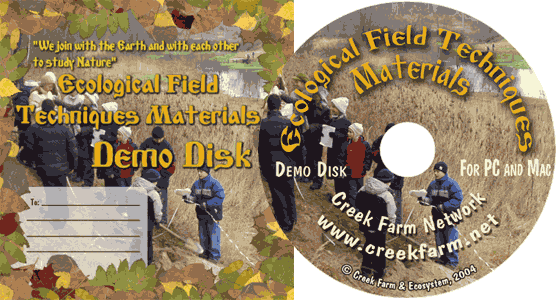|
| Our Field Ecology Center published more than
180 methodical materials for nature studies. Some of them are in English: |
|
|
|
The Study of Plants in Your Local Environment
© Alexsander S. Bogolyubov,
Nadejda S. Lazareva, Russia, 2002
© Michael J. Brody, USA,
2003
 In this manual we describe the procedure for the simple
but laborious work on the compilation of plants list (flora) of your local environment. We
describe a general scheme for the organization of the study, including selection of routes
for surveying, collection and description of plants for a herbarium as well as the
identification of plant species and writing a final report. In this manual we describe the procedure for the simple
but laborious work on the compilation of plants list (flora) of your local environment. We
describe a general scheme for the organization of the study, including selection of routes
for surveying, collection and description of plants for a herbarium as well as the
identification of plant species and writing a final report.
This field study has instructional video
featuring real students conducting the ecological field techniques in nature. Each video
illustrates the primary instructional outcomes and the major steps in accomplishing the
task including reporting the results.
Introduction
One of most frequently studied topics in botany is the compilation of the flora of an
area under study. Here we use the word "flora" to mean a list of plant
species growing in a given area. When working with students it is usually assumed that it
is a list of vascular plant species (i.e. Lycopodiales order, Equisetales,
fern-like (Preropside order), Gymnospermae and anthophytes (flowering
plants). Typically, work with algae, lichens and mosses require special and
extensive knowledge and skills for which only advanced students would be prepared.
It should be noted, that although this activity seems to be quite simple, in fact, it
is rather laborious, requiring respect for field science methods and detailed,
specific performance techniques. It often requires extended periods of time. A map of
the area and a field notebook are required for the field part of the activity, and a plant
field guide and a powerful magnifying glass or binocular microscope are necessary for lab
work.
We suggest conducting this field study within the framework of a series of educational
field studies, combining herbarium making and a geobotanical description of the vertical
structure of the forest.
Performing field work
The procedure for conducting the field part of the activity is quite simple: the study
area should be examined as carefully as possible and all species of plants growing
in the area under study should be identified. In fact, it may be almost impossible for
students to visit all secluded corners of the study site, so we suggest the following
approach.
First, prior to field studies, students should study a map of the general area
and determine the borders of the study site. If this activity is conducted by a group of
10-15 students having one or two days are available, we recommend a study site of about
1-3 kilometers. This is provided that the area is more or less known to student
researchers and their teachers and there is an accurate map of the area available. If the
area is not known it will take more time, up to several days, to get some idea of the
given area. It will also take more effort to orient students to the area.
If a map of the vegetation of the given area (or at least a map of the main vegetation
types) is available, it will greatly facilitate the work. A prior student map, which has
been made in the course of previous ecological field study lessons such as mapping forest phytocenoses
(winter #4) or a complex landscape profile (fall #8), will be of great use.
Regardless of the availability of a map, the activity begins with making a list of the main
plant associations and a sampling plan (survey). It is recommended to list at least
5-6 main vegetation types (plant associations, biotopes), which are characteristic of the
given area Ц for instance, different types of forests, meadows, swamps, water-bodies and
so on.
The student group is then divided into working teams of two people; each team is
provided with a separate sampling route. These routes should be determined so that the
students cover as many diverse habitats as possible. It is possible that students will not
be able to visit all planned sites in one day. The time to conduct field activities is
entirely dependent on the diversity of vegetation found in the given area, the distance
covered, and the energy of the students.
Each team records all plant species in the course of the whole study route. If
student researchers are familiar with and know plant species names for certain, they ...
This was only the first page from the manual and its full version you can see in the
Ecological Field Studies Techniques Video 4CD Set:
It is possible to purchase the complete set of 40 seasonal Ecological Field
Studies Techniques Video (in mpg format) in an attractive 4 compact disk set.
These compact disks are compatible with Mac and PC computers.
The videos are suitable for individual student or whole class instruction. To purchase the complete 4CD set
write to ecosystema1994@yandex.ru in a free form.

Ecological Field Studies Demo Disk:
We also have a free and interesting demonstration disk that explains our ecological field studies approach.
The demo disk has short excerpts from all the seasonal field study videos as well as sample text from all the teacher manuals.
The disk has an entertaining automatic walk through which describes the field study approach and explains how field studies meet education standards.
You can also download the Demo Disc from ecosystema.ru/eng/eftm/CD_Demo.iso.
This is a virtual hybrid (for PC and Mac computers) CD-ROM image (one 563 Mb file "CD_Demo.iso").
You can write this image to the CD and use it in your computer in ordinary way.
You also can use emulator software of virtual CD-ROM drive to play the disk directly from your hard disk.

|







